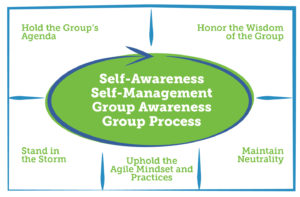Within a group, storms emerge from opposition and high-tension situations.
While storms are places of difference, they are also places of energy.
Most groups do not naturally want to stay in conflict situations. In fact, they usually have patterns of avoiding them, often at all costs.
What does this mean for you, the facilitator of the group?
This article will help you navigate team conflict by giving you tips on how to weather the storm.
What is Standing in the Storm?
The facilitation stance of ‘Standing in the Storm’ is about being able to recognize the storm and understanding how to weather it – because there is greater clarity in a group’s thinking on the other side.
Standing in the storm is about staying with conflict and difference instead of avoiding it, recognizing that different points of view provide clarity, discernment, deeper understanding and energy.
When There’s a Storm on the Horizon
When there’s a storm on the horizon, it’s easy to imagine that the meeting will completely unravel, that you’ll be blamed, and that you’ll look like an ineffective facilitator.
Anxious thoughts may creep in:
- How do I handle this much opposition?
- What if we don’t achieve what we need to do today?
- How will I be viewed?
Storms are those places when working with a group feels uncomfortable. For you or for them. For one person or the whole group. But standing in it together is a profound way to transform discomfort into something more productive and thoughtful.
Putting ‘Standing in the Storm’ into Practice: 3 Tips
As the facilitator what do you need to believe about yourself and your group as you facilitate?
Here are the guiding principles I reference in my book.
- Honoring the Wisdom of the Group
- Maintaining Neutrality
- Upholding the Agile Mindset and Practices
- Standing in the Storm
- Holding the Group’s Agenda
Today, I’d like to share three tips to help you stand in the storm.
1 Cultivate self-awareness and management to stay in the situation.
When put into a situation where you as the facilitator are standing in a storm, self-awareness is an important tool to stay in that storm, especially if you are asked to move on from a ‘high-heat topic’.
The first step to take is to ask for context.
Next, you need to clarify what happens moving forward.
The important thing to recognize when learning to stand in the storm is that staying with situations and group dynamics can feel difficult. So start practicing in small ways to help you prepare for the big moment.
2 Learn to Press “Pause”
Sometimes what’s needed in the midst of a storm is your own personal ‘pause’ button.
Because when you feel like slowing down and taking a breath is the very last thing you can do, it’s exactly what you need to do!
Learn to recognize these moments and to be prepared to take your pause, even when it feels like the hardest thing.
- Plant your feet firmly on the ground and stand with the principles of this facilitation stance
- Take a deep breath
- Remember that whatever is happening is not really about you. It’s about them
- Slow down the pace for yourself.
As the group responds to your pause, gather data about what’s happening for them. This will help you decide what to do next.
Remember you don’t have to figure out the next four things. You just need to figure out the one thing that will move the group forward in this moment.
3 Deepen your understanding of Group Dynamics
Models and frameworks for understanding group dynamics help us make sense of what we’re experiencing in the room.
Structural dynamics is a theory of face-to-face communications developed by David Kantor.
It provides a way to naming, at four different levels, the structure of communication as it’s taking place in the moment.
These are called
- Move
- Follow
- Oppose
- Bystand
In order for conversations to be skillful and effective, groups need all four of these actions to be voiced in conversation. Learn more about structural dynamics here.
The Art & Science of Facilitation
Without difference, there is no insight, clarity, energy, passion, or conviction. Storms give us these things – which means we have to stay with the storm no matter how uncomfortable it feels.
Read the Art & Science of Facilitation to dive deeper into this topic of ‘Standing in the Storm’ and watch this space for more on the facilitation stances mentioned in my book.

